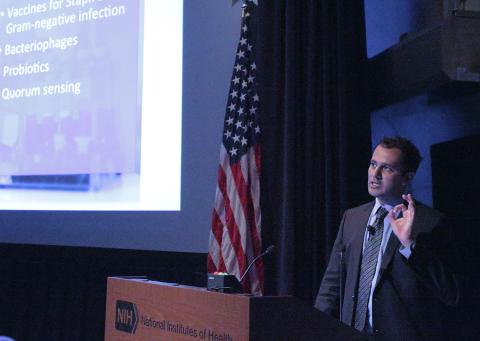Antibiotic Use, Resistance Threaten Global Health

Photo: Bill Branson
The problem isn’t new. Scientists observed antibiotic resistance 75 years ago, before penicillin was ever used. However, as antibiotic use rises rapidly worldwide, resistance continues to climb. It is now a burgeoning public health threat. How can we conserve these miracle drugs so they continue to fight disease and save lives?
“We started having a significant health burden associated with resistance only in the 2000s, and that has contributed in large part to the advocacy and to the policy action—at least to the talk of policy action—that we hear today,” said Dr. Ramanan Laxminarayan, an economist and epidemiologist who is director and senior fellow, Center for Disease Dynamics, Economics & Policy. He spoke to a packed Lipsett Amphitheater at NIAID’s John Ring LaMontagne Memorial Lecture recently.
Antibiotic use has risen by more than 36 percent in 72 countries from 2000 to 2010. Rising incomes—especially in such emerging economies as Brazil, Russia, India, China and South Africa—largely account for the growing global access to antibiotics. And high-income countries remain large consumers; U.S. per capita antibiotic consumption, for example, is double that of India and triple that of China, said Laxminarayan.
The fact that more people have access to antibiotics than ever before would be a beneficial trend if they were always used correctly. But rampant overuse and misuse of these vital drugs, in people and animals, have contributed to the dangerous rise of drug-resistant bacteria. And when antibiotics stop working, it becomes harder to fight serious, sometimes deadly, bacterial infections.
Some of the most stubborn infections come from the Gram-negative pathogens such as carbapenem-resistant Klebsiella, prevalent in China, India and Vietnam. MRSA and other resistant staph infections are rampant and still on the rise in Latin America and sub-Saharan Africa. Throughout Europe, E. coli infections are becoming harder to treat, having become resistant to newer antibiotics, and strep pneumoniae is also spreading rapidly. Globally, there already are more than 900 beta-lactamase enzymes that have been detected, which contribute to resistance to such mainstay antibiotics as penicillin.
Among the hardest hit populations are babies, children and seniors. Newborns are particularly at risk in developing countries where the mortality rate is high from neonatal sepsis, said Laxminarayan. In India, 58,000 babies die annually because of antibiotic resistance. In the United States, more than 100,000 seniors contract resistant infections annually, thousands of them fatal, while undergoing common surgical procedures.
But in developing countries, “lack of access [to antibiotics] very likely still kills more people than antibiotic resistance does,” said Laxminarayan, especially young children who often don’t get vaccinated. Vaccines reduce penicillin-susceptible disease and protect the most vulnerable populations, so it’s urgent to expand access to vaccines and reserve antibiotics for those who need them most.
“In the West, antibiotics were used as a mop-up operation after we’ve had public health [measures, such as fluorinated water] reduce the burden of infectious diseases,” said Laxminarayan. “But many other countries are using antibiotics not as a complement to public health but really as a substitute for public health.” He emphasized the need for access to clean water and better sanitation and infection control worldwide.
Reining in the improper use of antibiotics would dramatically reduce the global health burden of resistance. In some countries, notably India and Kenya, antibiotics are commonly sold without a prescription. In China, hospitals rely on antibiotic sales for much of their revenue, so there’s no incentive to reduce consumption. Around the world, antibiotics are incorrectly prescribed during the annual flu season.

Photo: Bill Branson
Meanwhile, another major impetus for antibiotic resistance is the increased use of growth-promoting antibiotics in livestock. Some 63,000 tons of antibiotics were consumed in livestock in 2010, said Laxminarayan, and the amount is projected to rise by 67 percent between 2010 and 2030. The daily low-level, or sub-therapeutic, dosing to fatten livestock doesn’t actually promote much growth, he said, but it does accelerate drug resistance. And studies show that antibiotics may be unnecessary to prevent disease if there’s good herd hygiene, nutrition, sanitation and veterinary care.
“If we don’t conserve the antibiotics we have, we will have to rely on new antibiotics that will be inevitably more expensive to develop and bring to market,” said Laxminarayan. And new antibiotics won’t solve the problem for long because resistance arises to every antibiotic just a few years after it’s introduced.
“We have to keep in mind that a lot of people may not be able to afford those newer antibiotics, so the loss of first-line drugs always increases the costs,” he said.
Luckily, many of our existing antibiotics do still work.
“If we spend a lot of public money trying to find new antibiotics, we are effectively dis-incentivizing people from using existing antibiotics appropriately,” said Laxminarayan.
He called for educating health professionals and the public about the need to use antibiotics appropriately and not demand them from doctors. Improving water, sanitation and immunization worldwide could help. So could providing incentives that encourage antibiotic stewardship and hospital infection control and the use of rapid diagnostics to prevent the unnecessary prescribing of antibiotics. He also advocated reducing, and eventually eliminating, sub-therapeutic antibiotic use in livestock.
“What we are dealing with is not just a problem of antibiotic resistance but really a problem of access to effective antibiotics, which many of us take for granted,” said Laxminarayan. “And the real tragedy will be when those people who currently don’t have access will finally be able to afford an antibiotic, [and] that antibiotic will not work for them, not because they overused the antibiotic, but because the rest of us did.”
